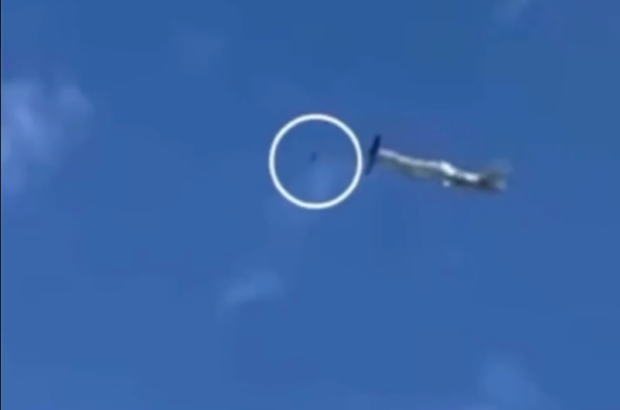The two aircraft collided during this year’s annual Wings Over Dallas airshow, hosted by Commemorative Air Force, an organization dedicated to preserving World War 2-era (WW2-era) aircraft.
The deadly incident, which claimed the lives of six crew members, was captured on camera and widely shared on Twitter. In the video, the gigantic B-17 bomber is seen flying straight and not very high, while a Bell P-63 Kingcobra comes in from the other direction.
The P-63 rams into the B-17 bomber and both aircraft break apart and crash to the ground. This is followed by an explosion and black smoke emanating from the debris.
In the latest video, the P-63 can be seen colliding with what appears to be a drone, which causes the fighter to stall, presumably because of the engine failure. The collision or near collision with the drone forces the P-63 to change course dramatically and dive into the B-17 bomber.
An expert told the EurAsian Times, “I cannot clearly see the drone. What I see is the P-63 in a steep climb. The aircraft then appears to lose control. It starts to sink at slow speed as if in a stall.”
The B-17 was a cornerstone of US air power during WW2 and was deployed in daylight missions against Nazi Germany. Most B-17s were destroyed at the end of WW2, according to Boeing. Now the remaining ones are put on displays at museums and air shows.
On the other hand, the P-63 Kingcobra, developed by Bell Aircraft during WW2, was not accepted for combat use by the United States. It was, however, widely deployed by the Soviet Air Force, which also operated the Kingcobra’s predecessor, the Bell P-39 Airacobra.
Source: Eurasian Times


They should be able to find pieces on the ground. If it was a drone they should prosecute.
I dont belive it to be a drone. I am a commercial operator and watched this several times it doesn’t seem to be a drone.
Absolutely no evidence of a drone being involved has been found. No official report or conference has even made comment on the possibility. This is because no drone was involved.
Thousands of people who are pilots, aircrew and otherwise involved with aircraft has seen and commented on the many videos available on this crash.
It is a tragic accident, possible due to mismanagement of the airspace by the Commemorative Air Force
The P63 was in a banked turn, producing plenty of power and was apparently told to move to the 500 yard flyby line, which meant it had to cross the approach to the 1000 yard flyby line that the B17 was lining up on. In the banked turn, the p-63 pilot could not see the bomber until it was too late.
Simple as that.